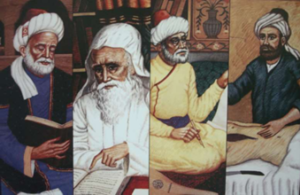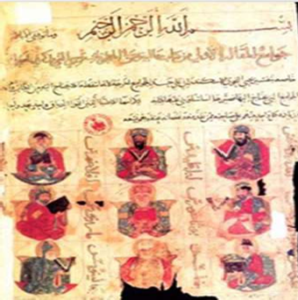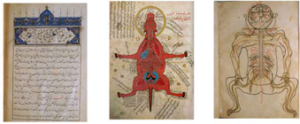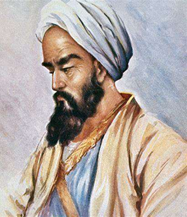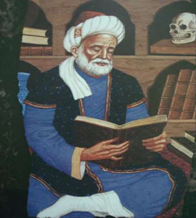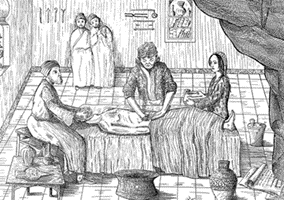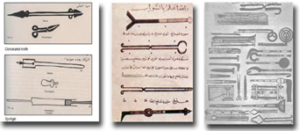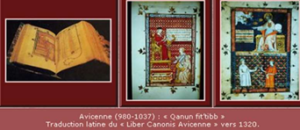
Abstract
Human knowledge in all fields and disciplines has been developed over thousands of years, every new generation takes the knowledge discovered previously and either adds onto it or corrects any errors found within it. There is a disturbing misconception even within Western Scientific Literature regarding the role of the Islamic Golden Age scholars. Often perceived as mere translators of previous generations’ knowledge, their role in the development of the human knowledge is often overlooked and underappreciated.
In truth, If the scholars of the Islamic Golden Age had merely preserved honestly the ancient cultures without adding anything else, that would be a great contribution to the human web of knowledge by itself. Notable examples include the works by Hippocrates and Galen, all other copies of their works were lost or destroyed except for their Arabic versions. However, their contributions were not only limited to this and in fact there were many new fundamental developments to the web of knowledge that took place in this era, including the work of Al-Khawarizmi in the field of Mathematics and Ibn Al-Haytham in the field of Optics. The field of Medicine is no different, with many significant developments taking place in the Islamic Golden Age particularly surrounding Neurosurgery (the subject of focus in this article). The aim is to explore the progression of neurosurgical knowledge and how the works developed or transmitte from the Islamic Golden Age have major implications for practice today.
Introduction
In the beginning of the eighth century, the intellectual centre of the world shifted towards the Middle East and flourished until the beginning of the 13th century. It is this period that we refer to as the Islamic Golden Age. During this era, the Islamic and Arabic scholars were of paramount importance in guarding the knowledge that had been accumulated throughout history, particularly the contributions of Greek and Roman scholars. The greatest known examples are the works by Hippocrates and Galen, all other copies of their works were lost or destroyed except for their Arabic versions. The scholars of this age were primarily responsible for transmitting these works to later generations, which have even survived until now. In addition to preserving this wealth of knowledge of other great civilisations, these Middle Eastern scholars, including physicians such as Avicenna, Albucasis and Rhazes made significant contributions of their own to both medicine and neurosurgery (Rahimi et al, 2007). Many points regarding ancient Arabic and Islamic sciences need to be discussed and clarified further in Western Literary circles, but this article will predominantly be focused on the history of neurosurgical practice, instruments and the development of neurosurgical knowledge and techniques during the Islamic Golden Age. Furthermore, this article will explore the ways in which this knowledge was developed during the Era in question, including the translation of other civilizations’ works and through research conducted by Islamic Golden Age contemporaries.
The fundamental principles used more than one thousand years ago for learning and developing medical and surgical skills are still hugely relevant in our time. For example, improving our neurosurgical skills now depends on one approach: practicing in the lab, studying anatomy and cadaver dissection. This practice gives us the right experience to carry out our work, and it is the same principle used ten centuries ago by Islamic and Arabic scholars in medicine. In the introduction to his book, Albucasis pointed out that good practice in surgery requires a sound knowledge of anatomy or the patient’s life will be in danger (Aciduman, Belen and Simsek, 2006).
Ibn Rushd Al Andalosi(Averroes 1126-1198)was a philosopher and a physician, he said: “He who is engaged in the science of anatomy, increases his belief in God (Savage-Smith,1995).This quote from Ibn Rushd provides a great insight into the motivation to learn and study that drove many physicians of the age to make new discoveries. Many factors including the correct understanding of Islamic principles, the political stability of that era, along with the tolerance and assimilation of different cultures played an important role in the rise of such an exceptional civilization. The idea that developing and contributing to anatomical and basic sciences would elevate their ranks spiritually provided encouragement to develop and improve their practice.
It was likely this drive to attain a worldly and spiritual success that drove Albucasis to invent skull perforator and guide Avicenna the non-sinking to think about tracheal intubation by golden tube to support breathing. In the same way as the heritage of the ancients was studied with great respect, non-Muslim scientists, Jews, and Christians in particular, were respected and played important roles in the scientific community. It was the open, non-dogmatic atmosphere that encouraged people to engage in debate, share ideas and seek new knowledge by asking questions and examining evidence(Hehmeyer and Khan, 2007). This concept of discussing new findings and scrutinizing evidence is the basis of medical and surgical conferences today, with physicians and surgeons from all over the globe engaging in a critical appraisal of evidence. Some notable individuals included the famous anatomist Uhanna ibn Masaweh (d. 875), known as Joannes Damascenus, who carried out his anatomical animal dissection under direct support from the Caliph. These scholars also included Ishac al Israilie, Honein ibn Ishak (Joannitius 809-873), and many others.
FIG 1 Portrait of Albucasisand other Arabic scholars
FIG 2 Arabic translation of Galen work on the first page as a reference documentation
Scientific background for an exceptional civilization
Near the beginnings of the Islamic Civilisation in the 7th and 8th centuries, medicine went through its first period, the translation and preservation of knowledge pioneered by previous generations. In the 9th century onwards, it took on the role of contributing to the development of new knowledge for future generations.
The translation of older works was supported by the government, Caliphate, at that time and this support shows us how important translation was for improving society, and it was done in an honest way. For example, the Caliph al Maamoun paid a translator the weight of his translation in gold.
Mentioning the original works of ancient scholars as references on the first pages of these Arabic books was done as proof of the translator’s respect and honest translation.
As a government policy to observe and control the medical occupation in 931, the Abbasid Caliph in Baghdad ordered the chief court physician, Sinan Ibn Thabit, to screen the 860 physicians in Baghdad. Only those who qualified were granted a license to practice (Spink, Lewis,1973).
This demonstrates how much their work was politically supported. This is one of the earliest examples in human medical history of government regulation in medical practice which has proved to be such a vital tool in Western Nations to ensure a consistent and excellent standard of care to be delivered to patients.
Fig 3: Anatomical books and diagrams for animals and human body
Contributions and Developments to Neurosurgery
Abu Bakr al Rhazi’s (Rhazes 850-923)
Abu Bakr alRhazi’s (Rhazes 850-923) contribution to neuroanatomy is well documented in his works in Kitab al-Hawi fi al-Tibb (The comprehensive book of medicine) and Kitab al-Mansuri fi al-Tibb (The book on medicine dedicated to al-Mansur). He described nerves as having both motor and sensory functions and as originating in pairs from the brain and spinal cord with membrane coverings (Rahimi et al 2007). He was the first physician to describe concussion (Rahimi et al, 2007), (McCrory and Berkovic, 2001) also in his book are lessons to his students to avoid injuring the small nerves while making the surgical flap, he states: “The surgeon must therefore know the anatomy of the nerves, the veins, and the arteries, so as not to sever them by mistake.”(Aziz, Nathan, McKeever, 2000), (Stephenson,1930).Contrary to Galen’s belief that the brain, spinal cord, and ventricular system were single structures, Rhazes correctly hypothesized that these were paired structures (Awad, 1995).
FIG 4 Portrait of Rhazes
He divided the peripheral nerves into eight cervical pairs, 12 thoracic pairs, five pairs in the lumbar spine, and three in the sacral spine, and he used this knowledge of segmental nerve innervations to pioneer the localization of lesions in patients (Flamm, 1967), a methodology that now forms a fundamental part of clinical examinations now whereby specific motor and sensory functions are tested to assess the condition of specific nerves.
There was a patient who presented complaining of numbness in his little finger after neck trauma, Rhazes said this patient must have a problem in the last cervical vertebra because he knew from his anatomical studies that the nerve from the last cervical vertebra goes to that finger. Rhazes described the ascending laryngeal nerve and noted there might be two or double branches on the right side and changed the concept of Galen that the brain, spinal cord, and ventricles are single structures, Rhazes confirmed that they are paired structures (Rahimi et al, 2007).
Abu Alkasem Al Zahrawi (Albucasis 936-1013)
“Without doubt Albucasis was the chief of all surgeons” Pietro Argallata (d. 1423) (Al-Ghazal, 2004). Albucasisis considered the father of operative surgery (Nabri, 1983). (Masić et al, 2000), and father of Modern surgery by others (Al-Zahrawi – Wikipedia, 2021), (Ahmed, 2008). Before the Islamic era, surgery was considered inferior to medicine, and surgeons were held in lower esteem. Albucasiswas the one of first to separate and classify surgery as distinct from internal medicine. Surgery was referred to as hand work or iron work, and this was the title of Albucasis’ tremendous book Atasreef. The 30th chapter was titled “On Surgery or hand work”. (Spink, Lewis,1973). He was born in 936 AD in Al-Zahra’, a suburb, six miles northwest of Cordoba, the capital of Spain (Andalusia) at that time. His ancestors were from the Al Ansar tribes of Al Madina Al Munawwarah who came from the Arabian Peninsula with the Muslim armies which conquered and lived in travelled rarely and spent most of Spain. Albucasis his life in his hometown as a practicing physician-pharmacist-surgeon(13) (Amr and Tbakhi, 2007).
FIG 5 Portrait of Albucasis
He could not achieve this level without advancing the other medical fields, so he developed for the first time the anaesthetic sponge. Before that era, anaesthetic solution was given in multiple doses to patients to make them unconscious for surgery, but Albucasiswas the first to use a sponge steeped in aromatics and soporifics and then dried. When anaesthesia was required, the sponge was moistened and applied to the patient’s lips and nostrils. The Arabic innovation was to immerse the anaesthetic sponge in a boiled solution of water and hashish (from Arabic hasheesh) opium (from Arabic afiun), c-hyoscine (from Arabic cit al huscin), and zo’an (Arabic for “wheat infusion”), which acted as a carrier for the active ingredients after the water evaporated. Such anaesthesia by inhalation was called “Arabian Nights” (Al-Fallouji, 1997). Albucasis was also a pioneer in developing surgical instruments. In his encyclopaedia, he introduced more than 200 illustrations of surgical tools with descriptions of how they work. As proof of his large number of craniotomies, he explained that he struggled with dural tearing while making burr holes. As a result, he was the first to introduce a non-sinking skull trephine for skull access, using a circular margin to avoid plunging into brain tissue and lacerating the dura (Goodrich, 2004). He was aware of the need for aseptic technique and used alcohol from wine during surgical procedures (Nabri, 1983) and keep the surgical tools ready for emergency cases. Albucasis was the first physician to explain a surgical treatment option for the temporal headache syndrome now known as temporal arteritis. He explained that relief from headaches could be provided by cauterizing the superficial temporal artery or ligating it with thread (Savage-Smith, 2000).
FIG 6 Portrait by Dr Qatay of Albucasis using his Anesthetic sponge during surgery, original manuscript in Al-Assad Library Damascus, Syria
FIG 7 Surgical tools of Albucasis with description and the way to use it, 30th Chapter (On Surgery) Atasreef liman agiza an Ataaleef, original copy in Wellcome institute, London 1973
Albucasis contributed to early descriptions of neurosurgical diagnoses and treatment including management of head injuries, skull fractures, spinal injuries and dislocations, hydrocephalus, subdural effusions headache and many other conditions (Al-Rodhan and Fox, 1986). He described vividly a case of hydrocephalus due to congenital defect of drainage of cerebrospinal fluid: “I have seen a baby boy whose head was abnormally enlarged with prominence of the forehead and sides to the point that the body became unable to hold it up”. (13)
Albucasis was also the first to use surgical cotton, (which itself is derived from the Arabic word qutn) as a medical dressing for controlling haemorrhage (Savage-Smith, 2000). He discovered the cat gut for internal suturing, by noticing the dissolving nature of catgut when his lute’s strings were eaten by a monkey (Al-Zahrawi – Wikipedia, 2021) and used the thermal cauterization to stop vessels bleeding (Spink, Lewis,1973). He also described the first study of intracranial hydrocephalus in a new-born, while others spoke about the extra ventricular collection of cerebrospinal fluid (Al-Zahrawi – Wikipedia, 2021). Albucasis was ahead of his time in the realm of neurosurgery. His contributions were crucial in bridging the knowledge gap in the world of medicine from the Middle Ages to the more modern period following the 15th century (Rahimi et al,2007) and his surgical teachings were the most advanced in the Middle Ages until the thirteenth century 20. Al-Tasreef was an essential component of the medical curriculum in European countries for many centuries. (14) The famous French surgeon Guy de Chauliac (1300-1368) quoted him over 200 times in his book appended its Latin edition to his own book on surgery. Several editions of this book (surgical chapter) were published including one at Venice (1497), at Basel (1541) and at Oxford (1778).
Albucasis’ influence continued for at least five centuries, extending into the Renaissance, evidenced by al-Tasrif’s frequent reference by French surgeon Jaques Delechamps (1513-1588) (Spink, Lewis,1973). He also wrote of the importance of a positive doctor-patient relationship and wrote affectionately of his students, whom he referred to as “my children”. He also emphasized the importance of treating patients irrespective of theirsocial status. He encouraged the close observation of individual cases to make the most accurate diagnosis and the best possible treatment (Al-Zahrawi – Wikipedia, 2021). For perhaps five centuries during the European Middle Ages, it was the primary source for European medical knowledge and served as a reference for doctors and surgeons. In Al-Tasrif, Abū al-Qāsim introduced the use of ligature for the blood control of arteries in lieu of cauterization almost 600 years before AmbroiseP aré (Al-Zahrawi -Wikipedia, 2021) (Shehata, 2002), (Millán, 1999). Albucasis used and developed the modern plaster and adhesive bandage, which are still used in hospitalsthroughout the world (AT THE THRESHHOLD OF A NEW MILLENNIUM III, MG Vol. 1 No. 3, 2021). The use of plasters for fractures became a standard practice for Arab physicians, though this practice was not widely adopted in Europe until the 19th century (Abdel-Halim et al, 2003). The street in Córdoba where he lived is named in his honour as “CalleAlbucasis” and he was considered the father of modern surgery (Al-Rodhan and Fox, 1986), Pietro Argallata (d. 1453) described Abū al-Qāsim as “without doubt the chief of all surgeons” (Al-Ghazal,2004).
Abu Ali al-Husayn ibn Abd Allah ibn Sina (Avicenna980-1037)
Canon fi Tibb, by Avicenna was the second most published book (after the Bible) since the invention of publishing (25). Ibn Sina (Avicenna 980-1037) was one of the foremost philosophers and physicians of the golden age of the Islamic era. His encyclopaedia, The Canon of Medicine, bridged the gap between eastern and western cultures (Rahimi et al, 2007). He was honoured in the west with the title Prince of Physicians. In one of his annotations, he describes making a cranial incision and the way to avoid eyelid nerves: When one decides to make an incision or opening one should take into consideration the various small and larger folds of the skin. In the case of the forehead however one would act otherwise because an incision along the folds there would divide the muscles and cause drooping of the eyelids. Similar care must be taken in the case where the muscular fibres take a different course to the surface folds. The surgeon must therefore know the anatomy of the nerves, the veins, and the arteries, so as not to sever them by mistake (Rahimi et al, 2007), (Stephenson,1930).
Also describing the values of spinal cord situation: “Nerves innervating the hands and feet would travel a longer distance and, thus be more prone to injury…Therefore, God created the spinal cord below the brain. The spinal cord is like a channel coming out of a fountain in the way that nerves emerge from both sides and go down, thus putting the organs closer to the brain”(25). He also described the vertebrae of the cervical, thoracic, and lumbar spine as well as the sacrum and coccyx in detail, he gave us the terms vermis and tailed nucleus, from which the medical landmark caudate nucleus is derived. Furthermore, he described meningitis, which he considered to be inflammation or a tumour of the envelopes of the brain. Avicenna used electrical shocks to treat epileptic and psychiatric patients by using the thunder fish, or electrical fish, which he kept alive in water to avoid losing its charge, this was truly a remarkable discovery which later paved the way for Electroconvulsive Therapy (ECT) to be used in patients with severe epilepsy who are not responding to typical antiepileptics including benzodiazepines such as Lorazepam.
FIG 8 Avicenna Latin translations
The Canon was translated into Latin by Gerard of Cremona in the 12th century, and superiority to Galen’s medical book, because of its it became the textbook used for medical education in European schools for more than six centuries (Aziz, Nathan and McKeever, 2000). During that period, it was the second most published book after the Bible since the invention of publishing (25). Avicenna tried to find an explanation for anatomic features, and he described the biomechanical features of the vertebra and the spine almost perfectly. He also described how the anterior longitudinal ligament is stronger than the posterior ligament because anterior movement is needed more than posterior movement (25) (Rahimiet al, 2007). His understanding of spinal anatomy allowed him to be one of the first to provide ways of stabilizing the spine. In The Canon of Medicine, Avicenna provides treatment options for spinal deformities such as kyphosis as well as for dislocations and fractures of the vertebrae (Aciduman, Belen and Simsek, 2006).
Furthermore, Avicenna described the craniovertebral junction and its injuries and said that injuries of the C1- C2 region are invariably fatal and cannot be treated. Unlike the ancient Greek physicians, he noticed the importance of dislocations of the upper cervical vertebra and describes their treatment. This contribution has had a huge impact on modern physiotherapy where a huge emphasis is placed on recovery and dislocation treatments in the top athletes of today. In addition, he described flaccid and spastic-type bowel and bladder dysfunction in patients with dislocations of dorsal and lumbar vertebrae (Aciduman, Belen and Simsek, 2006). This observation laid down the foundations for other physicians to discover serious conditions such as cauda equina syndrome which is considered a medical emergency. His book also contains a very good description about the trachea and its cartilages, ligaments, and function in speech, breathing and swallowing; when describing tracheal intubation by using a tube made from gold or silver, he said: “When it is necessary, we can introduce a metallic tube made from gold or silver to the Trachea to help breathing. “This was part of the Latin translation of his book (Liber Canonis) published in Vienna 1507.
FIG 9 Arabic original manuscript about tracheal intubation
The big lie.. the civilization gaps
Some people have tried to diminish these huge works by claiming that Islamic Golden Age scholars were only translators of other cultures and did not add new developments to medicine. It is an intellectual disservice to overlook such respectable pioneers of different geography and language that conjoined in one civilization. An honourable mention should also be given to Serefeddin Sabungouglu (1385–1468) despite establishing his works after the Islamic Golden Age. He was the author of Cerrahiyyetu -Haniyye (Imperial Surgery), which was written in Turkish in 1465., who worked as a royal physician in the Ottoman Empire in Anatolia in the 15th century, it was the first illustrated textbook of surgery in the Turkish medical literature, containing colour illustrations of surgical procedures, incisions, and instruments When Sabuncuog˘ lu completed Cerrahiyyetu¨ ’l-Haniyye in 1465, he was 83 years old, the book describes surgical management of spinal trauma, epilepsy, migraine, facial palsy, hemiplegia, low back pain, cranial fracture, and hydrocephalus he was treating Hydrocephalus by draining cerebral ventricles transcutaneously in hydrocephalic children (Elmaci, 2000) and sectioning the temporal artery for treating migraine. To summarize the approach taken towards practicing medicine in the Islamic civilization, Al Tabari (850) in his book “Firdaus al Hikma” (the Paradise of Wisdom) concentrating on the medical manners and the relationship between the patient and his doctor he stated:
The physician should be modest, virtuous, and merciful; he should be careful of what he says and should not hesitate to ask forgiveness if he had a fault. He should be forgiving and never seek revenge. He should be friendly and a peace maker. He should avoid predicting whether a patient will live or die; only God knows. He ought not to lose his temper when his patient keeps asking questions but should answer gently and compassionately. He should treat alike the rich and the poor, the master, and the servant. God will reward him if he helps the needy. He should not wrangle about his fees. If the patient was very ill or was an emergency case, he should be thankful no matter how much his fees. He should speak no evil of reputable men of the community or be critical of anyone’s religious belief. He should speak well to his colleagues, and he should not honour himself by shaming others (Al-Ghazal, 2007).
This description of the ideal medical professional and how they should act according to their ethics provides an insight into how ahead of their time the Golden Age contemporaries were. It contains many concepts that mirror medical practice recommendations given in the modern day including the GMC Good Medical Practice Guide.
Overall, this article has looked at the contributions to medical science, specifically neurosurgery, from the Islamic Golden Age through three of its most distinguished contemporaries. The discoveries were vast, ground-breaking, and still very much used and applied in the modern day.
References
- Aciduman, , Belen, D. and Simsek, S., 2006. Management of Spinal Disorders and Trauma in Avicenna’s Canon of Medicine. Neurosurgery, 59(2), pp.397-403.
- Ahmed M (2008). About Abu al-Qasim al-Zahrawi (Albucasis), father of surgery. [online] Islamic Medicine Forum. Available at: https://www.islamstickers.uk/forum/threads/about- abu-al-qasim-al-zahrawi-albucasis-father-of-surgery-m-ahmed.313/ [Accessed 13 November 2021].
- Al-Fallouji, M., 1997. Arabs were skilled in anaesthesia. BMJ, 314(7087), pp.1128-1128.
- Al-Ghazal, K., 2004. The influence of Islamic Philosophy and Ethics on the Development of Medicine during the Islamic Renaissance. JOURNAL OF THE INTERNATIONAL SOCIETY FOR THE HISTORY OF ISLAMIC MEDICINE (ISHIM), p.3.
- Al-Ghazal, K., 2007. The Influence of Islamic Philosophy and Ethics on the Development Medicine in the Islamic Civilization. Foundation for Science Technology and Civilization.
- Al-Rodhan, N. and Fox, J., 1986. Al-Zahrawi and Arabian neurosurgery, 936–1013 Surgical Neurology, 26(1), pp.92-95.
- Amr, S. and Tbakhi, A., 2007. Abu Al Qasim Al Zahrawi (Albucasis): Pioneer of modern surgery. Annals of Saudi Medicine, 27(3), p.220.
- Awad, , 1995. Galen’s anecdote of the fallen sophist: on the certainty of science through anatomy. Journal of Neurosurgery, 83(5), pp.929- 932.
- Aziz, , Nathan, B. and McKeever, J., 2000. Anesthetic and Analgesic Practices in Avicenna’s Canon of Medicine. The American Journal of Chinese Medicine, 28(01), pp.147-151.
- Elmaci, , 2000. Color Illustrations and Neurosurgical Techniques of ŞerefeddinSabuncuoğlu in the 15th Century. Neurosurgery, 47(4), pp.951- 955.
- wikipedia.org. 2021. Al-Zahrawi – Wikipedia. [online] Available at:<http://en.wikipedia.org/wiki/Abu_al-Qasim_al- Zahrawi> [Accessed 12 November 2021].
- Flamm, E., 1967. Historical Observations on the Cranial Nerves. Journal of Neurosurgery, 27(4), pp.285-297.
- Goodrich, J., 2004. History of spine surgery in the ancient and medieval worlds. Neurosurgical Focus, 16(1), pp.1-13.
- Hamarneh Al-Zahrawi, Abul-QasimKhalafIbn Abbas. In: Gillispie Charles Coulston., editor. Dictionary of Scientific Biography. XIV. Charles Scribner’s Sons Publishers; New York: 1976. pp. 584–585
- Hamidan Abu-Al-Qassim Al-Zahrawi; the Founder of Science of Surgery (Book in Arabic) 1993. Dar Magallat Al-Thaqafa, Publisher; Damascus, Syria.
- Hehmeyer, I. and Khan, A., 2007. Islam’s forgotten contributions to medical science. Canadian Medical Association Journal, 176(10), pp.1467-1468.
- Masić, I., Domres, B.D., Hadziahmetović, Z. and Toromanović, S., 2000. Abu al-QasimAz-Zahrawi–a great Arab surgeon. Medicinskiarhiv, 54(3), pp.187- 188.
- McCrory, , Berkovic, S., 2001. Concussion: The history of clinical and pathophysiological concepts and misconceptions. Neurology, 57(12), pp.2283- 2289.
- Millán, C., 1999. RoshdiRashed (ed.), Encyclopedia of the history of Arabic science, 3 vols., London and New York, Routledge, 1996, pp.xxviii, (0-415-12410-7). Medical History, 43(1), pp.139-142
- Milligazette.com. 2021. AT THE THRESHHOLD OF A NEW MILLENNIUM III, MG Vol. 1 No. 3.[online] Available https://www.milligazette.com/Archives/01-2- 2000/Art4.htm [Accessed 12 November 2021].
- Hussein, K.L. (1978), The Concise History of Medicine and Pharmacy (cf. Mostafa Shehata, “The Father of Islamic Medicine: An International Questionnaire”, Journal of the International Society for the History of Islamic Medicine, 2002 (2): 58-59
- Nabri, I.A. “El Zahrawi (936-1013 Ad), the Father of Operative ” Ann R CollSurg Engl. Mar 1983; 65(2): 132-134
- Abdel-Halim, R., Altwaijiri, A.S., Elfaqih, S.R, Mitwall, A.H. (2003), “Extraction of urinary bladder described by (Albucasis) (325-404 Abul-QasimKhalafAlzahrawi H, 930-1013 AD)”, Saudi Medical Journal 24 (12): 1283-1291 [1289].
- Rahimi, S., McDonnell, D., Ahmadian, A. and Vender, J., 2007. contributions from the Medieval neurosurgery: Middle East, Spain, and Persia. Neurosurgical Focus, 23(1), pp.1-4.
- Savage-Smith, E., 1995. Attitudes Toward Dissection in Medieval Journal of the History of Medicine and Allied Sciences, 50(1), pp.67-110.
- Savage-Smith, E., 2000. The Practice of Surgery in Islamic Lands: Myth and Social History of Medicine, 13(2), pp.307-321.
- Spink, S., Lewis G.L. (1973) Albucasis on Surgery and Instruments: A Definitive Edition of the Arabic Text with English Translation and Commentary. London: The Welcome Institute of the History of Medicine. 170-173
- Stephenson, J., 1930. A Treatise on the Canon of Medicine of Avicenna incorporating a Translation of the first Book. By Cameron Gruner M.D., (Lond.), pp. 612. London: Luzac& Co., 1930. Journal of the Royal Asiatic Society, 62(4), pp.923-928

